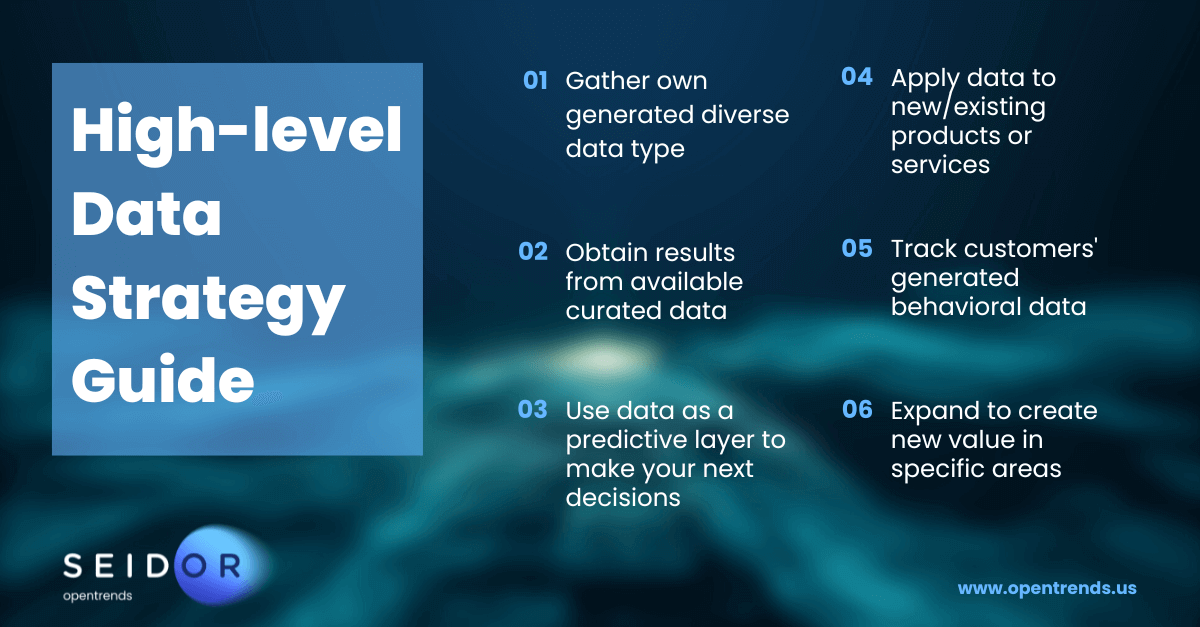
The power of Big Data: Unpacking the 5 Vs for Effective Data Management
Big data is the collection of data from different sources and is often described by five characteristics: volume, velocity, variety, veracity and value.
A truly digital company generates most of its revenues digitally and makes data-driven decisions. The big challenge is to leap from a subjective or speculative decision-making process to a data-rich one. Big Data analysis is the foundation for this leap to be possible by storing, processing and interpreting the generated data, and turning it into insights and knowledge. At a business level, the savvy use of data can make a huge difference, for instance, improve customer service, detect inefficiencies, predict failures early or develop competitive products and revenue streams.
To deal with data effectively and start seeing its advantages, take note of the 5 characteristics that make it big data. They highlight the challenges and opportunities of working with extensive data.
The Five Vs of Big Data

1. Volume
Today, each person produces approximately 2 MB of data every second, predicted to double yearly. Every minute alone, 188 million emails are being sent and around 4.5 million searches are done on Google.
The volume of data is so large that more than traditional data processing tools are required to handle it. The ever-increasing number of connected devices and machines, social networks, e-commerce and deployed sensors are some contributions to our gargantuan data generation world.
This is why Cloud, Cloud Native and advanced analytics (or AI) are among the top-growing disciplines in tech.
2. Velocity
The speed at which data is generated, processed and stored so that it can be interpreted in real-time or near-real-time. For instance, a sensor in a manufacturing plant may generate data every second. Analyzing this data in real-time may be critical to detecting any events before escalating into costly problems. A similar example would be the early collision sensors many of today's cars are equipped with. That data must be collected and processed early enough to avoid an accident.
Our world is filled with many digitally connected interdependencies for which data collection and processing speed become highly valuable. This is where connectivity plays a crucial role and the reason for the development of fog and edge computing disciplines.
3. Variety of types
The data collected comes from different sources such as websites, sensors, mobile devices, social networks, and in different formats such as video, text, numbers, image, audio or metadata. These can come from within organizations or externally and can be structured, semi-structured and unstructured.
The variety of data requires using different tools and techniques to process and analyze it, given that for instance, text processing differs from images.
4. Veracity
Refers to the quality and accuracy of the data. Data can be incomplete, inconsistent, or contain errors. With the increase in volume and variety, it becomes challenging to ensure the accuracy and reliability of the data. Veracity is critical to ensure that the insights and decisions made from big data analysis are reliable and accurate. Processes and procedures must be in place to ensure the data is trustworthy.
When processing data visualization plays a critical role. This is where graphing and dashboarding tools capable of handling the right volume of data and compiling it are essential.
5. Value
The value is the extraction of meaningful insights and knowledge gained from big data analysis. This analysis aims to help organizations make better decisions and gain competitiveness. The data itself has no value and will always need to be processed and analyzed to extract valuable information. The value of big data can be measured by the insights gained and the impact on business outcomes.
A big part of our work at Seidor Opentrends is finding ways for our clients to make sense of their data to drive business value and instill a data-driven growth mindset. Once we have a better understanding of customers' needs, there are techniques to retain them, and we specialize in that through growth hacking strategies.
Next Steps
Analyzing data can positively impact organizations by improving their services and products, reducing costs and increasing efficiency. You can make more precise data-backed-up decisions thanks to identifying behavior patterns, trends or anticipating threats.
Every business needs a data strategy that treats data as a source of innovation, new revenue and strategic advantage. If you are in the early stages of defining and implementing big data start with this 6-step guide or contact us to learn more.

FAQs about big data management
Why is effective data management important?
Effective data management is important because it allows organizations to:
- Store and process large amounts of data efficiently and cost-effectively.
- Analyze data in real time, which can be critical for making timely decisions.
- Make sense of diverse data sets, leading to new insights and opportunities.
- Ensure the accuracy of data, which is essential for making informed decisions.
- Extract value from data, leading to improved business performance.
How can organizations manage the volume of big data?
Organizations can confidently manage big data volume through distributed storage and processing, cloud computing, data compression and archiving, data filtering and sampling, data lifecycle management, data aggregation and summarization, and data governance and quality practices.
How can big data be used to improve business decision-making?
Big data can be used to improve business decision-making by providing insights into customer behavior, market trends, and operational efficiency. For example, to track customer purchase patterns to identify trends or needs, which can then be used to develop new products or services. Big data can also be used to monitor operational efficiency to identify areas where costs can be saved.
What are the challenges of big data management?
Challenges in big data management include managing the sheer volume of data, processing its high velocity, integrating diverse data types, ensuring accuracy and reliability, and extracting valuable insights pose significant difficulties.
What are the benefits of big data for businesses?
Big data benefits businesses with improved customer insights, operational efficiency, enhanced decision-making, and enables identifying new revenue streams through product/service innovation.


